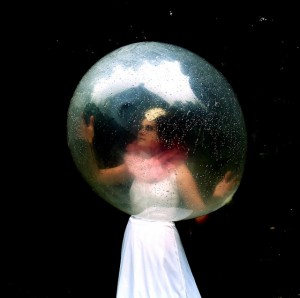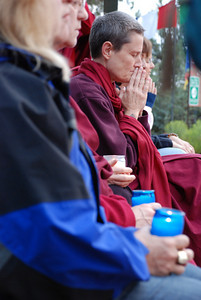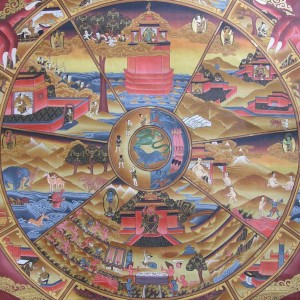
An excerpt from a teaching by Jetsunma Ahkon Lhamo called “Stabilizing the Mind”
In order to practice the Buddha’s teaching with any meaning, you first have to understand that all sentient beings are suffering. Now I have to ask you: Have you really seen that with your own heart, with your own eyes, with your own mind? Have you seen that all sentient beings are suffering?
If you have seen that you are suffering, then let me describe a funny little thing that you still do that cannot coexist with that knowledge. You have circumstances throughout the day (and throughout the month, the year, your life) that either please you or displease you, that either make you happy or make you unhappy.
You may think, “Oh, I’m really down today.” Then you talk to someone, and someone has an upbeat thing to say to you. It’s meaningful, it’s good, and it pleases you. So what happens to you? You go up, right? There’s a nice sense of warm fuzzies, and you go up.
Or let’s say you are a renunciate, a monk or nun, and when you wake up in the morning, it’s a ho-hum day. You’re in a flat-line zone, a kind of grey zone. And let’s say you manage to get in all of the practices that you want to do in the morning, and you manage to have a pretty good experience with them. You feel buoyant in your practice. You feel stable in your practice. You’re able to hold your visualization. Somehow that magical thing that happens every now and then happens. You had a good practice. Then you have your breakfast, eating your cereal by the window like a guy in a commercial, and you say, “Morning is my time!” But later on the dog urinates on your one robe, you are too busy to eat any lunch or any dinner, and you have a bad practice. That’s the worst thing – you have a bad practice – and things are no longer going so well.
These things happen to all of you, and yet, although you say you know that there is suffering from the depth of your heart, you have looked to satisfy the end of suffering in a way that is different from what the Buddha taught. We let our minds float on an ocean of waves like a buoy, up and down. What is “up”? What is “down”? And who is feeling it? Who says morning is your time? Who says evening is not? Who says life is good when you go out to a restaurant and have a glass of wine? These are concepts that are part of your mind, and your consciousness floats on them. For some of you, there is not a moment of spaciousness in your mind where your consciousness is not floating on some circumstance you contrived all by yourself. Why does that happen?
You say that all sentient beings are suffering and that the end to suffering is enlightenment, yet you allow your mind to be satisfied going up and down according to circumstances. All of the beings that you say are suffering are doing the same thing. Has anyone achieved happiness by allowing the mind to float on that ocean of concept that we call samsara, affected by circumstances, lifted up by what we call high circumstances, put down by what we call low circumstances?
No one. Never. The Buddha tells us that samsara is not happiness, that the contrivances of the mind are not happiness, that sentient beings are suffering, and that the only end to suffering is enlightenment. Yet we allow ourselves to slide up and down every day. We get excited about some project, we get enthusiastic, but it always comes to a dead stop. It always ends. It has never, never, never, never, never continued until it gave you supreme happiness.
So here’s the point I am trying to make. First brick: All sentient beings are suffering. Now, we’ll put the next one on top of it: There is an end to suffering, and it is enlightenment. Just two bricks, and already we find that we are not secure behind those two bricks, that we don’t believe. Yes, you say that you believe that all sentient beings are suffering. Yes, you say that you believe enlightenment is the end of suffering. Can you tell me how that can coexist with the tendency to let your mind drift, relying on circumstances to make it happy, being the victim of circumstances that make it unhappy? How do we allow that?
We forget. We’re caught in a dream, and we lose faith. So how are you going to practice this Vajrayana, the Diamond Vehicle, the Tantric teachings of Buddhism, passed from teacher to disciple, that can lead to the attainment of enlightenment in one lifetime, a path with sincerity and stability for the rest of your life until some potential comes for you to achieve supreme enlightenment? Do you believe that that can happen?
Copyright © Jetsunma Ahkon Lhamo. All rights reserved


